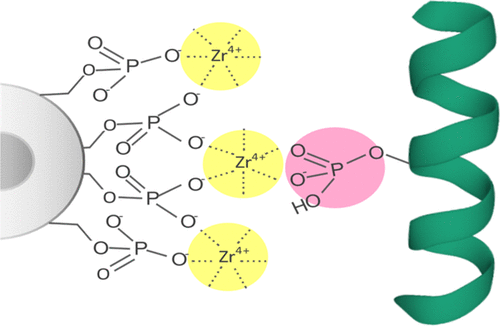当前位置:
X-MOL 学术
›
J. Proteome Res.
›
论文详情
Our official English website, www.x-mol.net, welcomes your
feedback! (Note: you will need to create a separate account there.)
Zirconium(IV)-IMAC Revisited: Improved Performance and Phosphoproteome Coverage by Magnetic Microparticles for Phosphopeptide Affinity Enrichment
Journal of Proteome Research ( IF 3.8 ) Pub Date : 2020-11-23 , DOI: 10.1021/acs.jproteome.0c00508 Ignacio Arribas Diez 1 , Ireshyn Govender 2 , Previn Naicker 2 , Stoyan Stoychev 2, 3 , Justin Jordaan 3, 4 , Ole N Jensen 1
Journal of Proteome Research ( IF 3.8 ) Pub Date : 2020-11-23 , DOI: 10.1021/acs.jproteome.0c00508 Ignacio Arribas Diez 1 , Ireshyn Govender 2 , Previn Naicker 2 , Stoyan Stoychev 2, 3 , Justin Jordaan 3, 4 , Ole N Jensen 1
Affiliation

|
Phosphopeptide enrichment is an essential step in large-scale, quantitative phosphoproteomics by mass spectrometry. Several phosphopeptide affinity enrichment techniques exist, such as immobilized metal-ion affinity chromatography (IMAC) and metal oxide affinity chromatography (MOAC). We compared zirconium(IV) IMAC (Zr-IMAC) magnetic microparticles to more commonly used titanium(IV) IMAC (Ti-IMAC) and TiO2 magnetic microparticles for phosphopeptide enrichment from simple and complex protein samples prior to phosphopeptide sequencing and characterization by mass spectrometry (liquid chromatography–tandem mass spectrometry, LC–MS/MS). We optimized sample-loading conditions to increase phosphopeptide recovery for Zr-IMAC-, Ti-IMAC-, and TiO2-based workflows by 22, 24, and 35%, respectively. The optimized protocol resulted in improved performance of Zr-IMAC over Ti-IMAC and TiO2 as well as high-performance liquid chromatography-based Fe(III)-IMAC with up to 23% more identified phosphopeptides. The different enrichment chemistries showed a high degree of overlap but also differences in phosphopeptide selectivity and complementarity. We conclude that Zr-IMAC improves phosphoproteome coverage and recommend that this complementary and scalable affinity enrichment method is more widely used in biological and biomedical studies of cell signaling and the search for biomarkers. Data are available via ProteomeXchange with identifier PXD018273.
中文翻译:

Zirconium(IV)-IMAC:磁性微粒对磷酸肽亲和力富集的改进性能和磷酸化蛋白质组覆盖率
磷酸肽富集是通过质谱进行大规模定量磷酸化蛋白质组学必不可少的步骤。存在几种磷酸肽亲和力富集技术,例如固定化的金属离子亲和层析(IMAC)和金属氧化物亲和层析(MOAC)。我们将锆(IV)IMAC(Zr-IMAC)磁性微粒与更常用的钛(IV)IMAC(Ti-IMAC)和TiO 2磁性微粒进行了比较,以从简单和复杂的蛋白质样品中富集磷酸肽,然后进行磷肽测序和质量表征质谱法(液相色谱-串联质谱,LC-MS / MS)。我们优化了样品上样条件,以提高Zr-IMAC-,Ti-IMAC-和TiO 2的磷酸肽回收率的工作流程分别减少了22%,24%和35%。优化的方案导致Zr-IMAC的性能优于Ti-IMAC和TiO 2,以及基于高效液相色谱的Fe(III)-IMAC,鉴定出的磷酸肽多达23%。不同的富集化学显示出高度的重叠,但磷酸肽的选择性和互补性也有所不同。我们得出结论,Zr-IMAC改善了磷酸化蛋白质组的覆盖范围,并建议这种互补且可扩展的亲和力富集方法被更广泛地用于细胞信号传导的生物和生物医学研究以及寻找生物标记物。数据可通过ProteomeXchange获得,其标识符为PXD018273。
更新日期:2021-01-01
中文翻译:

Zirconium(IV)-IMAC:磁性微粒对磷酸肽亲和力富集的改进性能和磷酸化蛋白质组覆盖率
磷酸肽富集是通过质谱进行大规模定量磷酸化蛋白质组学必不可少的步骤。存在几种磷酸肽亲和力富集技术,例如固定化的金属离子亲和层析(IMAC)和金属氧化物亲和层析(MOAC)。我们将锆(IV)IMAC(Zr-IMAC)磁性微粒与更常用的钛(IV)IMAC(Ti-IMAC)和TiO 2磁性微粒进行了比较,以从简单和复杂的蛋白质样品中富集磷酸肽,然后进行磷肽测序和质量表征质谱法(液相色谱-串联质谱,LC-MS / MS)。我们优化了样品上样条件,以提高Zr-IMAC-,Ti-IMAC-和TiO 2的磷酸肽回收率的工作流程分别减少了22%,24%和35%。优化的方案导致Zr-IMAC的性能优于Ti-IMAC和TiO 2,以及基于高效液相色谱的Fe(III)-IMAC,鉴定出的磷酸肽多达23%。不同的富集化学显示出高度的重叠,但磷酸肽的选择性和互补性也有所不同。我们得出结论,Zr-IMAC改善了磷酸化蛋白质组的覆盖范围,并建议这种互补且可扩展的亲和力富集方法被更广泛地用于细胞信号传导的生物和生物医学研究以及寻找生物标记物。数据可通过ProteomeXchange获得,其标识符为PXD018273。











































 京公网安备 11010802027423号
京公网安备 11010802027423号